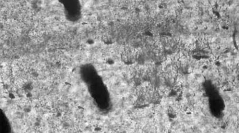

 Comptes Rendus Palevol
10 (5-6) - Pages 413-426
Comptes Rendus Palevol
10 (5-6) - Pages 413-426The long bone microstructure of four pachypleurosaurid taxa from Monte San Giorgio (Switzerland/Italy) was studied. Pachypleurosaurids are secondarily aquatic reptiles that lived during the Middle Triassic in varying marine environments of the Tethys. All four pachypleurosaurids show high compactness values in their long bones based on a thick cortex and a calcified cartilaginous core, which remains in the medullary region throughout the ontogeny. Parts or even the entire embryonic bone layer composed of a mixture of woven-fibered bone tissue and parallel-fibered bone tissue is preserved in both pachypleurosaurid genera. The rest of the cortex consists of lamellar-zonal bone tissue type. Differences in the microstructure of the bones between the pachypleurosaurids are reflected in the occurrence of remodelling processes, which, if present, affect the innermost growth marks of the cortex or the calcified cartilaginous core. Further variation is present in the spacing pattern of the growth cycles, as well as in the degree of vascularisation of the lamellar-zonal bone tissue type. Our data on the microstructure of the long bones support previous studies on morphology and facies distribution, which indicated different habitats and adaptation to a secondary aquatic lifestyle for each pachypleurosaurid taxon. Life history data furthermore reflect different longevities and ages at sexual maturity. The bone histological data of the stratigraphically youngest and oldest pachypleurosaurid species might indicate possible climate-dependant reproductive seasons similar to Recent lacertilian squamates.
Sauropterygia, Bone histology, Skeletogenesis, Ecology, Life history, Switzerland, Italy